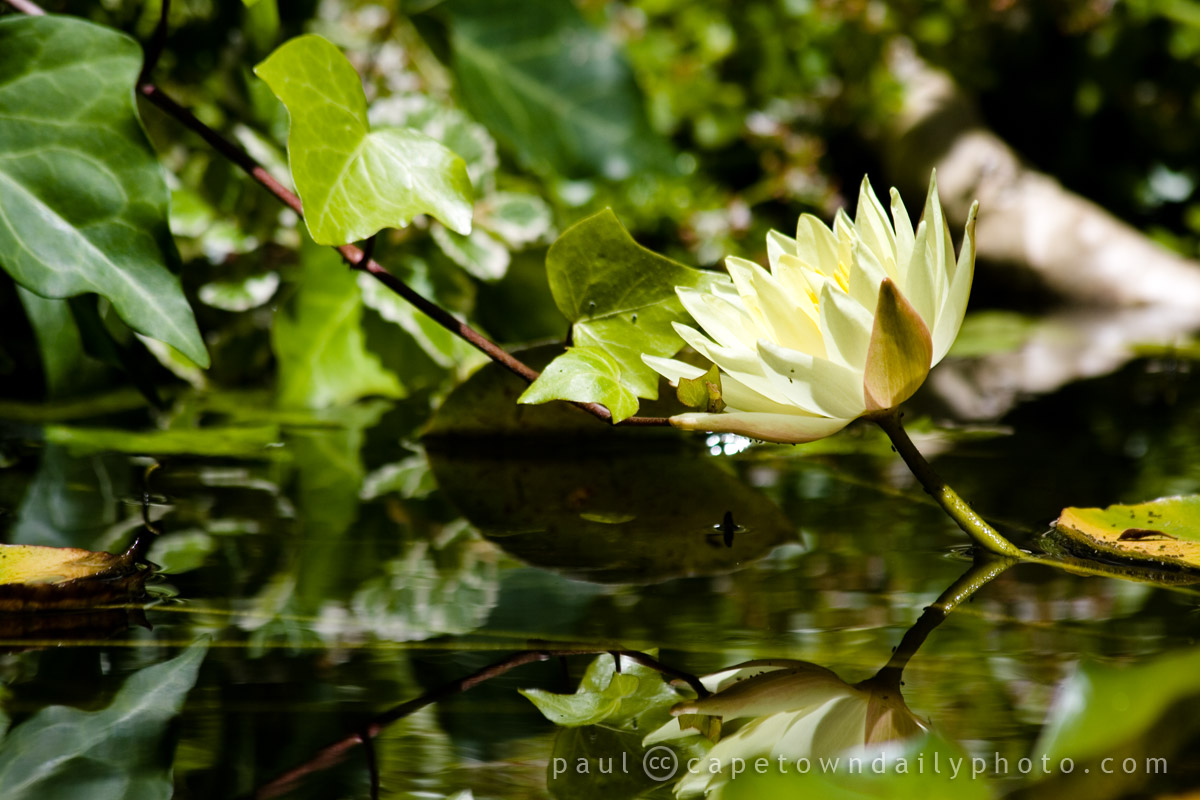The flower above is commonly known as a water lily, but to the botanists among you it's more likely known as a member of the Nymphaeaceae family, possibly either the Nymphaea Alba (White Water Lily) or the Nymphaea Capensis (Cape Blue Water Lily). What makes it difficult for me to decide is that the only references I've found so far to water lilies in the Western Cape talk about the Capensis, and yet this flower looks yellowish - a lot like the Alba. But the Alba is apparently found in the northern hemisphere, in places like England and North America.
That aside, I discovered an online store that sells what appears to be dried Nymphaea Alba. One can apparently use the dried flower to make a tea that, according to them, has the following effect: "White Lotus is both narcotic and euphoric. Like Blue Lotus, the plant is said to increase sexual arousal and enjoyment."
Now, while the name Nymphaea appears to support this, I'm keen for someone to (at their own risk ;) ) get some and give it a go. If you have tried the tea, then please do leave a comment below and let us know if you experienced any effects!

Celeste
Really beautiful pic, Paul. Thanks for sharing.
Er, I wonder what would happen if one smoked the stuff instead??
Tara
Well, it is entirely possibly that the white versions are an invasive species? Or alternatively, that ones with white flowers are a different hybrid/breed?
Paul
Post authorCeleste, if you do, let us know please. :D
Tara, I had a similar thought. Rhodes, or someone else, may well have introduced the White Lily.
Pieter
Paul, your waterlily is most likely an introduced hybrid such as Nymphaea ‘Sunrise’, ‘Colonel AJ Welch’ or ‘Sulphurea’. All three of these are primary hybrids between the American Nymphaea odorata and the Mexican Nymphaea mexicana, all three were created by the French nurseryman Latour Marliac during the late 19th century. They, along with Nymphaea alba (the European species), are frequently found growing naturalized in old farm dams where they form large colonies over time – they are not invasive though. These grow, and for that matter as do all “hardy” waterlilies, from a horizontal rhizome, and have flowers floating or slightly raised above the water.
Apropos Nymphaea capensis, these do indeed have pale blue (rarely white or pale pink) flowers. The grow from a stoloniferous tuber, and have flowers raised 20 to 30 cm above the water, as do all “tropical” waterlilies. This is one of three indigenous waterlily species to South Africa, the other two being, Nymphaea caerulea and Nymphaea lotus. Nymphaea caerulea is commonly known as the Blue Lotus, though it has no relation to true lotus (i.e. Nelumbo nucifera). A tea is made from the dried petals of Nymphaea caerulea, though I have not tried this.
White Lotus however probably refers to Nelumbo nucifera ‘Alba’ and not to any Nymphaea species, though it is hard to know for sure as these vernacular names are ofter used interchangeably for both Nymphaea and Nelumbo, and only serves to compound the confusion!
Today there are more than 600 named waterlily cultivars in cultivation in a magnificent range of colours!
Hope this little bit of info is helpful!
Pieter
Paul
Post authorHi Pieter,
Whoa, that’s a lot for my non-botanist brain to consume. :) Thanks for the information. Tell me though, how would one actually tell these apart? Would you have to inspect them under a microscope? As I said in the post, I did quite some hunting on the Web to try to identify this waterlily, and could only assume based on the pics that I found.
Perhaps the more important question however is, can you make tea out of this one? ;)
Gloria
Is there any place in Cape Town that one could buy the tea,plant or tincture to try?
Tim
I have indulged in Nymphaea Carrulea, Nymphaea Alba, Nymphaea Rubra as well as Nelembo Nucifera (blue lily of the Nile, White Lily, Red Lily and Sacred Lotus, respectfully, each on there own as well as well as in combination together) and all are vvonderful dear friends. Though with the descriptions given, you might be a little bit let down on the effects, but their still amazing plant pals and herbal helpers that I believe to be beneficial to many people for a variety of reasons.
The effects are subtle but also profound. For anxiety panic attacks or depression, they can be a powerful plant ally. They are all lightly euphoric, helpful for insomnia and completely safe for anybody unless you happen to be allergic to the plants, but I’ve never heard a single incident of this happening to anyone.
It’s also very potent for connecting to others and are all genuine ancient aphrodisiacs. If you approach these plants with the intention of getting stoned like weed or euphoric like opiates you’ll likely be quite disappointed, but I have (stupidly) ingested massive doses in the past with the desire of finding out what these plants are capable of and found absolutely no toxicity to speak of, at all friends.
If you approach these plants with respect and an open mind, you might just find yourself with a new floral friend and botanical buddy to help you get through difficult times in your life.
I hope that this helps anyone who may be on the fence of whether to take it or not, and if anyone has any questions or worries about this plant you’re more than okay to ask me and hopefully be able to help. Much love friends and take care! Sincerely your friend (that you’ve never met until now, but I’m still a friend damn it! HA!). Tim